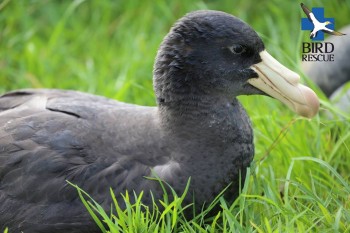As reported from time to time in ACAP Latest News sick and injured albatrosses and petrels taken under care to wildlife rehabilitation centres are released at sea or from the shore if they are deemed to have recovered sufficiently. ACAP-listed species known to have been released in this way include both species of giant petrels Macronectes spp. and Atlantic Yellow-nosed Thalassarche chlororhynchos, White-capped T. steadi, Wandering Diomedea exulans and Antipodean D. antipodensis Albatrosses. Countries which have released rehabilitated albatrosses and petrels include Australia, Brazil, Canada, New Zealand and South Africa, as well as the United Kingdom’s Tristan da Cunha.

A young Northern Giant Petrel under care in New Zealand
Such releases run a risk of introducing novel diseases and pathogens to the species’ wild populations, especially if the rehabilitated birds are released at or near their breeding sites.
To reduce this risk the Scientific Committee on Antarctic Research (SCAR) in 1996 adopted Recommendation XXIV-3 (see below) that urges against the reintroduction of rehabilitated indigenous animals to sub-Antarctic islands and to the Antarctic Continent. However, such reintroductions apply only to the SCAR area of interest* and do not affect the release of rehabilitated albatrosses and petrels north of the SCAR region as defined. Such releases carry the implicit assumption that only healthy and disease-free individuals are likely to make it back home.
Recommendation XXIV-3
Concerning re-introduction of indigenous species
Noting that well-meaning attempts have been made to rehabilitate indigenous seals and seabirds, especially penguins, that have been held in captivity, to sub-Antarctic islands and to the Antarctic continent;
Noting further that such re-introductions serve no useful conservation purpose and run the risk of introducing pathogens;
SCAR, therefore, urges National Committees to discourage such practices.
*SCAR’s area of interest includes Antarctica, its offshore islands, and the surrounding Southern Ocean including the Antarctic Circumpolar Current, the northern boundary of which is the Subantarctic Front. Subantarctic islands that lie north of the Subantarctic Front and yet fall into SCAR's area of interest include: Ile Amsterdam, Ile St Paul, Macquarie Island and Gough Island. http://www.icsu.org/what-we-do/interdisciplinary-bodies/scar/
Healy, M. 2007. Care of giant-petrels from rehabilitation to release. National Wildlife Rehabilitation Conference Proceedings 2007, Fremantle, Australia. 4 pp.
Vanstreels, R.E.T., Saviolli, J.Y., Ruoppolo, V., Hurtado, R., Adornes, A.C., Canabarro, P.L., Pinho, R., Filho, S. & Serafini, P.P. 2014. Diretrizes Para a Reabilitação de Albatrozes e Petréls. 12 pp.
SCAR 1997. SCAR XIV Recommendations. Polar Record 33 (185): 175-178.
Releasing rehabilitated albatrosses and petrels: avoiding the pathogen problem
John Cooper, ACAP Information Officer, 20 September 2014

 English
English  Français
Français  Español
Español